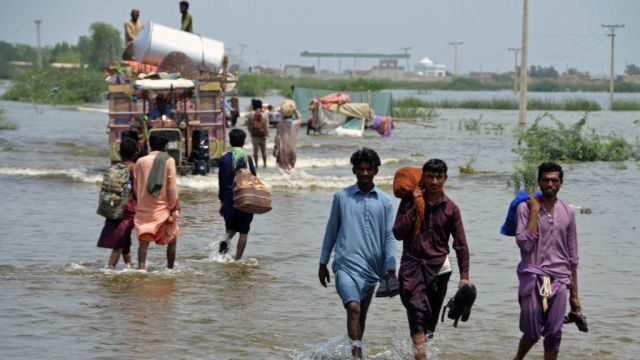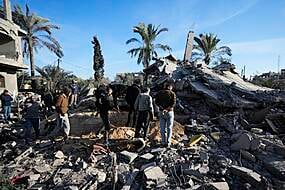Nearly half a million people have crowded into camps after losing their homes in widespread flooding in Pakistan.
The country’s climate minister warned that Pakistan is on the “front line” of the world’s climate crisis after unprecedented monsoon rains wracked the country since mid-June, killing more than 1,136 people.
The rains stopped more than two days ago and floods in some areas were receding.
But Pakistanis in many parts of the country were still wading through waters that filled their homes or covered their town’s streets as they struggled with how to deal with the damage to homes and businesses.

In one of the worst single incidents of the flooding, at least 11 people were killed on Monday when a boat that volunteer rescuers were using to evacuate two dozen people capsized in the flood-swollen waters of the Indus River near the southern city of Bilawal Pur, media reported.
An unknown number were still missing from the capsizing.
Climate minister Sherry Rehman and meteorologists told the Associated Press (AP) that new monsoons were expected in September.
Monsoons have hit earlier and more heavily than usual since the start of summer, officials say – most recently with massive rains last week that affected nearly the entire country.
Pakistan is accustomed to monsoon rains and flooding, Ms Rehman said, but not like this.
“What we saw recently in the last eight weeks is unrelenting cascades of torrential rain that no monsoon has ever brought with it ever before,” she said.
The heavy rains are the latest in a series of catastrophes that Ms Rehman said are exacerbated by climate change, including heatwaves, forest fires and glacial lake outbursts.

The damage reflects how poorer countries often pay the price for climate change largely caused by more industrialised nations.
Since 1959, Pakistan is responsible for only 0.4% of the world’s historic CO2 emissions.
The US is responsible for 21.5%, China for 16.5% and the EU 15%.
“Climate knows no borders and its effects can be disproportionately felt,” Ms Rehman said, adding “we’re on the front line of a global crisis”.
The National Disaster Management Authority said floods this summer have killed more than 1,136 people and injured 1,636, as well as damaging one million homes.
At least 498,000 people in the country of 220 million are in relief camps after being displaced, it said.
Many more displaced are believed to be living with relatives, friends or outside.
International aid was starting to flow into Pakistan, and the military was helping distribute aid to remote areas and evacuate those who had lost their homes.

Authorities were starting the long effort of rebuilding roads and restarting railways.
The floods destroyed more than 150 bridges and numerous roads have been washed away, making rescue operations difficult.
In the south-eastern town of Shikar Pur not far from the Indus River, Rehan Ali dug up bricks from the collapsed walls of his home, nearly completely destroyed by lashing storms and waters that raged through.
His family’s possessions were strewn around outside.
The 24-year-old labourer said he cannot rebuild without government help and cannot work now because of the turmoil.
“I don’t even have anything to feed my family. I lost everything. I don’t know where to go. God help me,” he said.
Arif Ullah, an official at the Pakistan Meteorological Department, told the AP that more rains will continue to lash parts of Pakistan next month.

Prime Minister Shehbaz Sharif on Monday said the rains so far have been the heaviest Pakistan has seen in three decades.
“I saw floodwater everywhere, wherever I went in recent days and even today,” Mr Sharif said in the town of Charsadda in the north-east of the country.
Some 180,000 people in the town have been evacuated after the Swat River overflowed and swamped nearby communities.
Mr Sharif has said the government would provide housing to all those who lost their homes.
But many of the displaced have lost not just homes, but also crops and businesses.
“I am sitting with my family in a tent, and how can I go out to work? Even if I go out in search of a job, who will give me any job as there is water everywhere,” asked Rehmat Ullah, a flood victim in Charsadda.
Zarina Bibi said soldiers evacuated her by boat.
She broke down in tears as she recounted how her house collapsed in the floods.

“We were given a tent and food by soldiers and volunteers,” she said.
“Floodwater will recede soon, but we have no money to rebuild our home.”
At least 6,500 soldiers were deployed to help, and authorities said they were using military planes, helicopters, trucks and boats to evacuate marooned people and deliver aid to them.
However, many displaced complained they were still waiting for help.
Some said they got tents but not food.
Pakistani authorities say this year’s devastation is worse than in 2010, when floods killed 1,700 people.
General Qamar Javed Bajwa, Pakistan’s military chief, said on Sunday that his country may take years to recover.
He appealed to Pakistanis living abroad to generously donate to the flood victims.

Cargo planes from Turkey and the United Arab Emirates began the flow of international aid, landing in Islamabad on Sunday with tents, food and other daily necessities.
The United Nations will launch an international appeal for Pakistani flood victims on Tuesday in Islamabad.
The flood wreckage has hit Pakistan at a time when the country faces one of its worst economic crises, narrowly avoiding a default.
Later on Monday, the International Monetary Fund’s executive board approved the release of a much-awaited 1.17 billion dollars (£1 billion) for Pakistan, Pakistan’s information minister Maryam Aurangez told the AP.
The announcement was a big relief for the country.
Pakistan and the IMF originally signed the bailout accord in 2019.
But the release of a 1.17 billion dollar tranche had been on hold since earlier this year, when the IMF expressed concern about Pakistan’s compliance with the deal’s terms under former prime minister Imran Khan’s government.
Last week, the United Nations in a statement said that it has allocated three million dollars (£2.5 million) for UN aid agencies and their partners in Pakistan to respond to the floods and this money will be used for health, nutrition, food security, and water and sanitation services in flood-affected areas, focusing on the most vulnerable.







